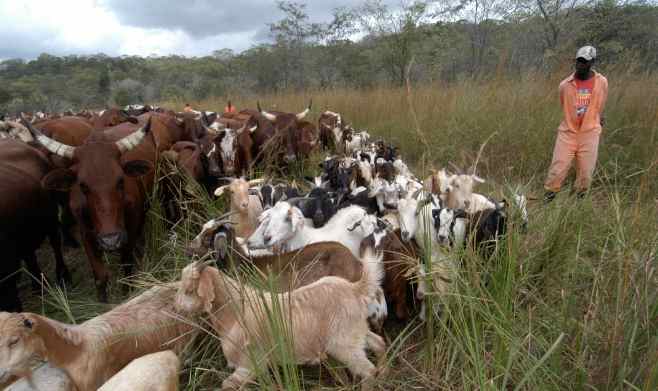We’ve all heard the mantra: meat is bad. Bad for your health. Bad for the land. Bad for global warming. Bad. Bad. Bad.
It is practically a battle cry. Thus, it is surely better for you and the environment to eat and buy less of this fleshy product – notwithstanding that it is protein-rich and instrumental in human evolution. It similarly follows that going meatless one day a week, or one week a year, is a smart environmental decision. Right? And we all know about the U.N. Food and Agriculture Organization’s (FAO) 2006 seminal report, Livestock’s Long Shadow, which equated livestock with cars in terms of their scourge on land and climate.
Well, for the most part, given the history of livestock production since the end of World War II when the industrial method of meat production started to take hold with concentrated animal feeding operations (CAFOs), this anti-meat philosophy is warranted and the documentation of its environmental damage is correct. It is also true that factory-farmed red meat is correlated with a wide range of illnesses. Thus, the modern system of meat production and our overconsumption, particularly of processed meats, is by and large deleterious to our health, the environment, and, in the case of CAFOs, ethically horrendous. There should be no argument about that.
There is a problem, however, with the sloganistic simplification of this predicament to “meat is bad” and resolving to avoid it as a way to help the climate and the environment. The problem is that it confuses our modern situation – which is unnatural in every way – with traditional ranching and meat products that were far healthier and more in concert with natural animal and land relationships. Even the FAO’s Long Shadow report is quite clear that the assessment is based on the conventional livestock industry, including all fossil fuel use and all land use degradation from the production of grain to support CAFOs. Simply avoiding meat products, without distinction as to their origin or production, threatens to victimize small scale, family run ranches, that may quite possibly be grazing in a manner that is across the board beneficial. These ranches may be preserving open space, sustaining wild prairie, avoiding fertilizers, pesticides, and animal antibiotics, while producing healthy meat and dairy products that have the proper ratio of Omega fats not found in grain fed livestock and that are essential for human health. Many of these smaller, sustainable operations may also, in fact, be close to urban areas where the demand is greatest – as opposed to the CAFOs that are thousands of miles from population centers. A suitable strategy would be to divert consumer dollars away from the modern behemoth of the factory farm, and toward the “good shepherds” whose enterprises we should be supporting.
There is also the opportunity for soil formation and carbon sequestration on most of the world’s highly depleted savannas and grasslands, which only ruminant herds in balance with perennial plants can affect. Blindly saying no to grazing is also saying no to the most potent resource we have to provide the biological impacts necessary to restore prairies to their native states. Large expanses of prairie simply cannot exist without tremendous herds of ruminants moving according to coevolutionary patterns of intense grazing followed by long periods of rest. This process is dictated by weather, predation, and naturally occurring fires. Without grazing animals there can be no deep-rooted perennial grass plants and no sequestration of carbon or retention of water on the largest ecosystem on the face of the earth, the grasslands, in all their myriad forms: prairie, savanna, steppe, and semi-desert.
Although the mismanagement of livestock grazing has indeed been part of the problem that has caused degradation of grasslands in the first place (combined with tillage for agriculture), it is also true that different approaches yield divergent outcomes. When livestock are mobilized in a fashion similar to that of wild ruminants, their impact can be restorative– reversing the very degradation that they may have previously caused. In fact, it is highly likely that livestock, properly managed in this way, are the only resource that can restore the damage to the majority of the world’s grasslands and re-establish the essential biological impact that was once provided by prodigious ruminant herds and their predators.
A practice called Holistic Management helps ranches to embrace exactly such a grazing approach, so that the animal effect is ecologically positive, as ruminant impact with prairie and savanna should be. At the Africa Center for Holistic Management in Zimbabwe, where I have visited twice in the last three years, the examples of restoration are extraordinary. Through managing livestock in tight packs, and moving and corralling the animals according to a carefully planned and monitored regimen, highly depleted, even barren landscapes, have been restored to healthy savanna. The result is vast fields with dense grass cover and a mix of both annuals and perennials – in less than a decade. By increasing grass cover, carbon is moved from the atmosphere to long-term storage in soils, water retention is enhanced and improvements in hydrology are apparent. Counter-intuitive as it might otherwise sound, growing the livestock herd, while radically changing management, has increased surface water availability, not lessened it.
It is exciting to realize that reversal of desertification and its substantive climate mitigation potential can be achieved through a simple rethink of our approach to animal husbandry. With this rethink also comes healthy food and a natural move away from CAFOs and their ills. Given this perspective, the “meat is bad” drumbeat is out-of-synch with the symphony of opportunity before us. Although the evidence of how not to manage animals is ubiquitous, let’s not allow that to obscure our vision of alternatives – alternatives that we must champion.











